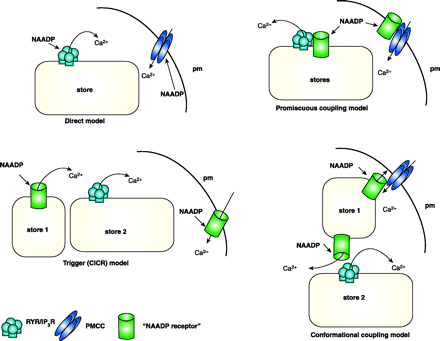
- Institution: Stanford Univ Med Ctr Lane Med Lib/Periodical Dept/Rm L109
- Sign In as Member / Individual
The NAADP Receptor: New Receptors or New Regulation?

Possible mechanisms for NAADP-induced calcium release.Direct model: NAADP binds directly to the RyR on Ca2+ stores (ER or acidic compartments) increasing the probability of the channel being open (53, 54). NAADP may also bind and directly regulate plasma membrane (pm) Ca2+ channels (PMCC). Trigger CICR model: This model assumes that there is a discrete NAADP receptor/Ca2+-release channel that is located in a discrete Ca2+-storage organelle (probably an acidic store) (store 1). Localized Ca2+ release from this pool then recruits IP3Rs and RyRs located in a second store [the ER (store 2)] by CICR and globalizes the Ca2+ signals (5, 20). Promiscuous coupling model: In this model, the NAADP-binding protein is not a Ca2+ channel per se, but rather is an integral membrane protein that can associate and regulate Ca2+-release channels such as RyRs (35), in the ER or acidic stores (including secretory granules), or calcium influx channels in the plasma membrane. Conformational coupling model: This model assumes that NAADP interacts directly with a distinct NAADP-regulated Ca2+-release channel in a discrete store. This channel can release Ca2+ in response to NAADP, but the channel may also directly interact with other Ca2+-release channels (IP3Rs or RyRs) or with plasma membrane Ca2+-influx channels. This model provides one explanation for how desensitizing concentrations of NAADP apparently render IP3Rs or RyRs insensitive to their respective agonists (56) or desensitize Ca2+ influx (14), even in the apparent absence of Ca2+ release. Permutations of any of the four models above are also possible. Another possibility is that distinct subtypes of NAADP receptors exist with different localizations, pharmacology, and functions.


